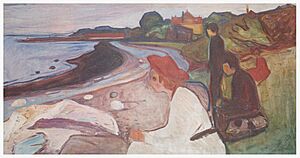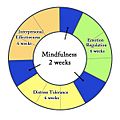Borderline personality disorder facts for kids

Borderline personality disorder (BPD) is a long-term mental illness. It affects how a person thinks and feels about themselves and others. People with BPD often have very strong emotions that can change quickly. This can make it hard to have stable friendships and relationships. They might also feel very sad or have low self-esteem.
Sometimes, people with BPD also experience other challenges, like feeling very down or worried. Getting help for BPD usually involves a mix of talking to a therapist and sometimes taking special medicines prescribed by a doctor.
Contents
What is Borderline Personality Disorder?
Borderline personality disorder, or BPD, is a type of mental health condition. It affects about 1 to 2 out of every 100 adults. People with BPD often have intense feelings and mood swings. These changes can happen very quickly, sometimes within hours.
It's called "borderline" because when doctors first identified it, they thought it was on the "border" between two other conditions. Now, we know it's a distinct condition.
How Does BPD Affect People?
People with BPD experience emotions very strongly. This can make everyday life feel overwhelming. They might feel a deep fear of being left alone or abandoned by friends and family. This fear can lead to them acting in ways that push people away, even though they don't want to.
Some common ways BPD can affect someone include:
- Strong mood swings: Feelings can change from happy to sad or angry very quickly.
- Impulsive actions: Sometimes, people might do things without thinking about the consequences.
- Low self-esteem: They might have a very negative view of themselves.
- Relationship challenges: It can be hard to keep friendships or romantic relationships stable due to intense emotions and fears.
- Feeling empty: Some people with BPD describe feeling a sense of emptiness inside.
- Difficulty managing anger: Anger can be very intense and hard to control.
Getting Help for BPD
It's important to know that BPD is a treatable condition. With the right support, people can learn to manage their emotions and live fulfilling lives.
Therapy and Support
The main way to help people with BPD is through therapy. One common type is called dialectical behavior therapy (DBT). DBT teaches important skills like:
- Mindfulness: Being aware of the present moment.
- Emotion regulation: Learning to understand and manage strong feelings.
- Distress tolerance: Finding ways to cope with difficult situations without making things worse.
- Interpersonal effectiveness: Improving communication and relationship skills.
Therapy helps people understand their feelings and learn healthier ways to react. It can also help them build stronger relationships with others. Sometimes, doctors might also prescribe medication to help with specific symptoms, like sadness or anxiety.
Support from Family and Friends
Having support from family and friends is very helpful for someone with BPD. Understanding and patience can make a big difference. Learning about BPD can help loved ones offer the best support.
Images for kids
See also
 In Spanish: Trastorno límite de la personalidad para niños
In Spanish: Trastorno límite de la personalidad para niños




